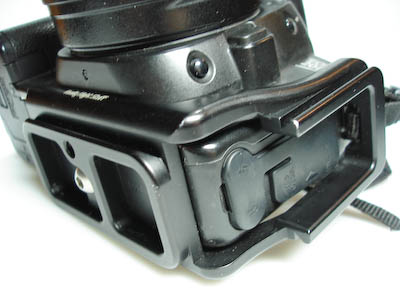Tripod
Introduction
The importance of a good tripod is often underestimated. Oftentimes its much more flexible and a faster way to take pictures without a tripod. If the light allows it and your creativity is increased by working with the camera handhold that’s OK. As long as you use a lens with relatively small and medium focal length you will seldom get in trouble if the light levels support short enough exposure time to reduce the handshake effect making pictures unsharp. But the dimmer it gets and the longer the focal length of the lens you are using, the higher the demand for a solid platform to mount your camera. Today’s cameras are getting more and more sensitive and the noise level is better with every new model coming out. Today (early 2008) one can easily use APS-C sensor cameras at 400 ISO without loosing too much quality due to increased noise. The newest models even allow getting higher. Image stabilisation techniques also help to be able to use the camera longer in the evening by reducing the effect of shaking. There are two approaches: Some cameras have the image stabilisation technique build into the camera body itself. With these systems you are able to use the anti-shake system with any lense attached. Other systems have the stabilisation mechanism integrated into the lens itself. In this case, the user needs to buy specific lenses with IS or VR (Image Stabilisation or Vabration Reduction) capability to use the anti-shake technique.
When do I need a tripod?
To answer that question we need to find how long you are able to produce sharp pictures with the camera
handhold. There is a rule of thumb which says that it is possible to use a lens up to the
longest exposure time of one divided through the focal length. This means that a 200mm tele lens could be used
up to a maximal time of 1/200th. The next closest time in this case would be a 1/250th
second. But what exactly means can be used
. Does it mean that the picture will look exactly the same
as if taken with a tripod? Is the sharpness of such a exposure equal to that of one taken with a
tripod or is the sharpness just acceptable. It’s clear that every person has a different shaking
hand
.
I.e. you probably need to do the shaking test yourself it you thing that my hand is an
especially shaky one.
The question of sharpness needs also a closer look. In film times, there was a definition that for maximum sharpness the unsharp circle should have a diameter of not more than 0.03mm which equals 30 micrometers (30 um). With today’s sensors it probably makes more sense to define the maximum unsharp circle diameter as the distance between two adjacent sensors. Let’s assume a APS-C sensor as this sensor type is widespread, at least today. An APS-C sensor has a crop factor of 1.6, which means that a lens with a certain focal length shows the opening angle of a lens which has a 1.6 longer focal length compared to the case, where the lens is attached to a camera with a full frame sensor. The question would now be: Which focal length do I need to use for the rule of thumb, the one stated at the lens or the one which is 1.6 times longer?
Let’s go back to the APS-C sensor. The size of such a sensor measures 22.5mm x 15mm. A 8Megapixel sensor shows 3500 pixels x 2330 pixels. The horizontal and vertical distance between pixels is then 6.5 um and 9um diagonal. A 12 Megapixel sensor shows about 20% smaller distances. Compared to the 30um unsharp diameter for film cameras the 9um distance of the 8Megapixel camera would be 3 times smaller. Does this mean a three times smaller exposure time? The only way to answer all these questions is to carry out a test with real life equipment.
Shaketest
For the test I used a the Canon 24-105mm/f4 IS L USM Zoom lens with integrated image stabilisation at 105mm mounted on a Canon 20D, a camera with APS-C size sensor and 8Megapixels. The calculations carried out above are also based on this sensor type. The fist picture of each segment is shot with an exposure time of 1/1000th second. Each following shot will get the double exposure time and the aperture will be closed by one stop, i.e. we will end up with the same exposure value. Closing the aperture will increase sharpness at least within the first 2 or three stops but this effect is relatively small for this lens and can be seen at the shots carried out with the camera mounted on the tripod. Mainly the first stop will increase sharpness and the effect is very small for al the following apertures. After about 4 stops the sharpness gets worse again. Even though the depth of field is increased the more you close the lens, the micro sharpness will decrease. For this lens, the best aperture range (looking strictly at sharpness) is from one stop closed throughout to 3 stops closed which is from aperture 5.6 through 11. The effects might be minor but they are clearly visible in the pictures below.
The pictures shown are displayed at pixel values 1 to 1 which means that one pixel of the original capture will be equal to one pixel on your screen.
I carried out this test with lenses of various focal lengths. The way you hold your camera influences the effect of the shaking hand. It depends if you have your elbows stretched out widely or if they are hold tight to your body and it also depends whether you are standing with all your weight on one foot mainly or if you are trying to find a very stable position or even lean on a wall or similar. Resting your arm on a stable platform may further decrease shaking effects. All the tests were made free standing and I tried to give my best to hold the camera as shake free as possible. You may succeed in holding your camera more stable but you really need to carry out the test yourself to find out.
The general rule of exposing a lens with a focal length of x by the maximal time of 1 divided through x seems to be quite useable but my tests show that shortening this time by a further factor of two is still increasing the sharpness in the pictures. The image stabilisation will increase the maximal time by a factor of 4 (2 aperture steps) but this is not always possible as the test shows. A more conservative value would be one exposure value increase.
I also tested the effect of lifting the mirror prior to exposure. On my camera, the mirror is lifted two seconds prior to exposure. You can also select to lift it manually any time prior to exposure but for the sake of repeatability and comfort I selected the automated way. The effect is very small on lenses with short focal length and can be neglected with the lens I used set to 105mm. I didn’t do the test with my 400mm lens but I guess the effect will be much higher.
The following exposure series were carried out all the same way with the same exposure values. I had to change the ISO settings to capture 8 exposures in a row with varying exposure times (simply because I’m not able to close this lens any further than f22). All test shots were carried out with the Canon 24-105mm/f4.0 L IS USM at a focal length setting of 105mm. The list below shows the exposure settings for each shot:
- 1/1000sec, f4.0, ISO800
- 1/500sec, f5.6, ISO800
- 1/250sec, f8.0, ISO800
- 1/125sec, f11.0, ISO800
- 1/60sec, f16.0, ISO800
- 1/30sec, f22.0, ISO800
- 1/15sec, f16.0, ISO200
- 1/8sec, f22.0, ISO200
The following 4 series were carried out:
- camera on Stativ, IS switched on
- camera on Stativ, IS switched on, mirror lift up activated
- camera handheld, IS switched on
- camera handheld, IS switched off
Comparing the different pictures shown below tells the story: Exposure times smaller or equal of 1/60th using IS will give adequate sharp results, without IS you’ll need 1/125th and for optimal sharpness you need to reduce the time by one stop. The rule for optimal results are therefore one stop more stringent compared to the rule of thumb mentioned above.
For best sharpness
lenses can be used handhold up to a maximum exposure time of
1/(2 x focal length)
The exposure variation is due the illumination used. All the pictures were recorded with artificial light powered at 230VAC with 50Hz. Short exposure time are more vulnerable to exposure variations. This has no influence on the overall sharpness. As noted above, the pictures shown are crops from the original photos displayed at 1 to1, i.e. one pixel of the original photograph equals one pixel on your display.



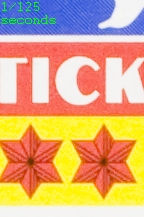




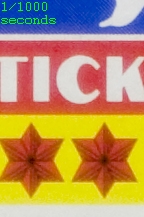









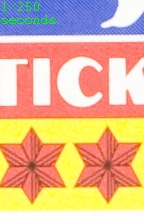











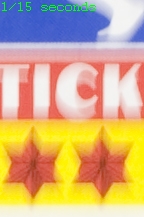
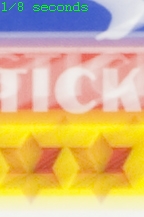
Tripod
As shown in the test results above, the maximal exposure time will limit the use of the camera handhold as soon as the light levels will drop. To get optimal sharp results, a tripod should be used as soon as exposure times get longer than one divided through two times the focal length. Long focal length lenses, i.e. teles are especially prone. First of all, their long focal length asks for shorter exposure times and secondly, these lenses are normally not that fast (i.e have not such a good maximal aperture) compared to wide-angle lenses or normal focal length lenses. It depends how you are planning to use the photo later on. For moderate enlargements or use on thee web the optimal sharpness will not be required. However, oftentimes it is unclear how you will use your photograph, if you will enlarge it to the maximum or if you just need it on your web page. The best quality possible is in these cases always the goal to give you maximum freedom for the later usage of the photograph. In the following sections we will therefore go into a detailed discussion abut all aspects of using tripods.
Material
Observing photographers in action I often have the impression that the tripod is one of the most underestimated objects for them. Many people will spend huge amounts of money on their cameras and lenses and will mount it later on a shaky, lightweight tripod with a maximal extension of 1.2m or so. Lightweight is important but light and stable are often contradicting requirements. Wind alone can limit the usability of your tripod. If a light breeze will carry away your tripod it’s possibly too light. Classical materials used are aluminium. These tripods are very rigid and stable but stability comes at the cost of weight. However, the weight will give extra stability. Lightweight material options are basalt or carbon which will increase the price tag. If you are schlepping the tripod on all your hiking tours the extra cost will probably be justifiable, but if you use your tripod mainly around your car it will probably makes not a big difference if your tripod is one kilo heavier. If the weight will reduce the usage, it’s better to choose a lighter one.
Height
Tripods which extend only to 120cm or even less are not really useable over a long time period. It will not allow you to look through the viewfinder without bowing over and your back will hurt after a while. This will also influence the way you see the picture. If you are not standing straight it’s much harder to level the camera or to opt for the best composition in your picture. A good ball head will have a height of 10cm and your camera will add another 10cm in height. For photographs requiring pointing your camera upward an additional height of 5cm is required. Your tripod should therefore be extendable up to the height of your eye minus 15cm. If your eyes are about 170cm above ground, a tripod of 155cm height will do the job. In this case, the Gitzo 1340 of 153cm height will be a good choice.
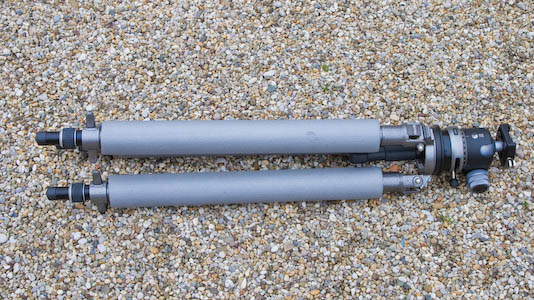
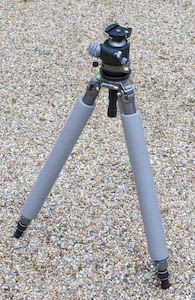

Middle Column
The middle column should only be used as an emergency option. The tripod height discussed above needs to be reached without the use of the middle column. As we are looking for a tripod with good stability it makes no sense to extend three legs with one leg, destroying all the stability the three legs offer by using a unstable one leg extension. The best is to use a tripod without a middle column which will opt your tripod to be used at low levels for macro-work and others. There are manufacturers which show the middle columns to be inserted upside down for macros. I once tried this technique and I think none of the manufacturers suggesting this has used this technique for a longer time. Controlling a camera that is mounted upside down is very awkward. Managing a camera which is hanging between the legs is very uncomfortable too. If you are shooting between two legs the third will hinder you to access the camera properly. It doesn’t make sense to extend a tripod to 1.5m if you would like to work 40cm above ground. Two points have to be addressed for macro work: The middle column should not be present as it will hinder the tripod to go close to the ground. Second: It should be possible to spread the legs to get closer to the ground (see next section.

Legs and Feet
Uneven ground requires the legs to be extended unevenly. Alternatively one or tow legs may be spread to correct for the slope. When using the tripod for macro photography all the legs should be spread to get as close to the ground as possible. It is quite comfortable to have some discrete spreading positions where the legs can be fixed as shown in the middle picture below.


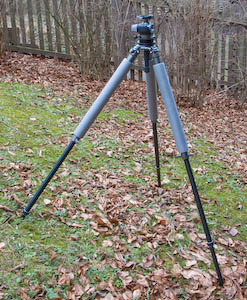
The fewer sections the more stable your tripod will be as intersections are prone to instability. Longer sections will make the tripod longer when folded together, i.e. it is less comfortable to transport. You need to find a compromise. Typically three sections are used for tripods up to 150cm, four segments should be omitted. The devices to fix the legs at a certain extensions should be very easy to handle and it also should be easy to handle them with gloves. Wingnuts are really nice. My tripod has them on the upper section. I was planning to exchange the lower fixings too but the reply from Gitzo was that this is not a standard modification and not possible. I’ll probably live with this or find a solution on my own.
Handling the tripod in the cold can be very uncomfortable. As metal has a very low resistance for heat transport it will cool down rapidly in a cold environment. It is therefore recommended to isolate the upper sections of your tripod. You can either buy special pipes for tripod use or you have to visit check out a local dealer for isolation pipes used to isolate water and heating tubes. To mount them on the upper legs you probably need to demount the lower leg sections and then simply pull the isolation over the upper leg section. If the isolation pipe is too tight some soap will help you reducing the surface resistance. Choose an isolation material which will not soak any water if used in rainfall. I also tested isolation material produced to be used for tripods but I think that the water pipe isolations are much better and more robust solution. In addition to that their cost is much lower. The isolation material will have the further advantage that carrying the tripod on your shoulder is now much more comfortable.

A good tripod will allow you to change the feet. There are different options available: Rubber feet are mounted as default, spikes, large pads, rollers or snow pads are available as an option.


Snow pads are especially useful in soft deep snow. They will prevent the tripod from sinking into the steep snow which will destabilize the tripod. If you are not using the snow pads the sunken tripod will not stand on the ends of the legs anymore but on the inner side of the lower leg segments. Snow pads can either directly be mounted on the standard rubber feet. Alternatively the screw on rubber feet will be exchanged by the snow pads. I use the ones which you will mount upon the standard rubber feet. They are fixed with a rubber band and I am impressed how good this mounting is. It looks quite fragile but in real life this is a good solution. The pads are installed very fast and lightweight to transport. A really good addition if you plan to use your tripod frequently in snowy regions.

Levelling Unit
The levelling unit is used in two cases. On uneven ground it allows to bring you tripod head in an even position for easier handling. For panorama photography it allows to exactly level the tripod head base which is required if you plan to stitch multiple photographs into one panorama shot. The latter could also be realized using a rotation platform on top of your ball-head but I thing the levelling unit is the more robust solution. The levelling Units will be mounted on tripods with a mounting platform. Most tripods which are shipped with a preinstalled middle column will not allow it to be exchanged later on for a levelling unit. It is therefore recommended to seek for a tripod with mounting platform that allows you to alternatively install a levelling unit or a middle column (but remember the discussion above when using the latter).
A levelling unit consists of a ball sitting in a equally formed opening. It will allow you to tilt you platform in any angle up to 15� from horizontal. The levelling is carried out by loosing the fixation with the middle grip sticking out of the bottom side of the unit. The same grip is used to level the base and to fix it afterwards. The levelling is such carried out using one hand only while you are holding your camera with the other hand. A spirit level will make this job easy to be carried out.

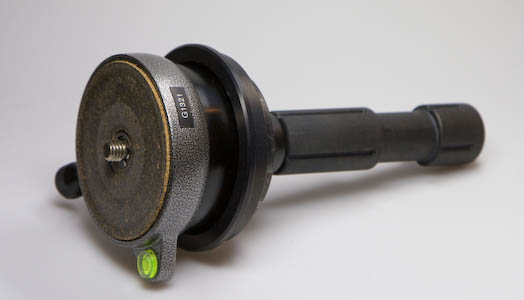

Tripod Haed
There are many different types of tripod heads available. The three main types used in photography are discussed:
- Ball Head
- 3 axis levelling head
- Gimbal Head
The Gimbal Head is a very special head used in tele photography, i.e. photography with long lenses like for wildlife or sports photography. In this case, the lens is mounted onto a U shaped plate. This allows to place the centre of gravity below the horizontal axis of the system making it a stable system, i.e. the lens will always return to the horizontal position if nicely balanced on the mounting. If nicely levelled it is also possible to hold the system in any angled position without much force. A knob allows you to fine tune the resistance and the heavy camera lens system can such be operated very smoothly. The Gimbal Head will allow vertical and horizontal movements but will not allow to turn the camera from portrait to landscape and vice versa. This is carried out by rotating the camera lens system within the mounting of the lens tripod adapter. The Gimbal Head is a very specialized head which is normally not used as a one fits all solution.

The 3 axis levelling head allows you to very exactly operate the camera system. This head has its origin in the film industry where it is required to fix a certain camera position while still being able to rotate the camera horizontally. Especially medium and large format cameras are operated using this head but it is also used in architectural photography. Some people also use it instead of the Gimbal Head for tele photography. Even though levelling with the three axis device is very accurate it is also time consuming as only one axis can be altered at a time.
The ball head is a very good compromise if you are looking for fast operation for a medium weight camera system. SLRs are optimal to be used with a ball head as their relatively small weight will fit into the weight ranges supported by most ball heads. Opening the fixation will allow you to move your camera in all three axes. After you found your optimal position one knob will fix all axes. Better model will allow controlling the horizontal rotation additionally with a separate knob. This means that loosing that knob will allow you to rotate the system without altering the other axes. This is realized by mounting the ball head on a rotating platform. This functionality is required for panorama photography.
One mechanical drawback of ball heads is that the center of gravity is above the horizontal rotation axis of the system. This means that the system is mechanically unstable: If you loosen the fixation, the camera will fall to the side if you are not holding it. Better ball heads will allow you to select how smooth the movements will be, i.e. how much friction is used. This is very nice when using a heavy camera system on the ball head. You will then dial in more friction and the system; will be much easier to operate. To keep stress from the ball fixation mechanics, two design criteria are important. First: A bigger ball with a larger surface will allow using a fixation mechanism with a larger surface to grip on. Second: The shorter the offset of the camera platform from the ball centre the lower the forces on the ball (lever rule).
The knobs of a good ball head should be operational even with gloves and different dimensions of the knobs will allow blind operation. Mechanical designs which will not require any lubricants will be much easier to operate as they do not require any maintenance.
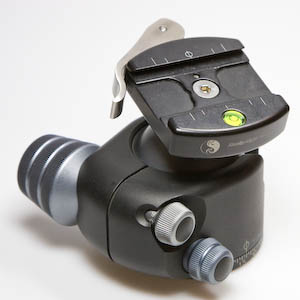

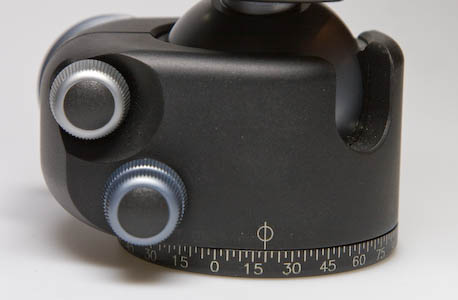
Camera platform and camera plate
It is straight forward to mount the camera to the tripod head using the screw on the head. A much easier and faster way is to use a dedicated camera adapter to mount it. The camera adapter consists of two parts. The camera platform is mounted on the tripod head and the camera plate is mounted on the camera or lenses itself. L plates for cameras allow mounting the camera either for the portrait or for the landscape format. The camera plate should be design to fit the camera body. Such, you can always leave the plate fixed to the camera even when not using the tripod. The plate should therefore be designed in a way not to hinder you accessing any controls. This requires the camera plate to be designed specifically for a certain camera model.
The most widely spread adapter is the Arca Swiss plate, which is available from different manufacturers. I also tested quick release adapters from Manfrotto and Gitzo. Both companies have different adapters and non of them is designed for a specific camera model. The plates mostly do not fit nicely to the camera; some of them are even difficult to mount to prevent rotation of the camera when mounted on the tripod. On some plates cork is used. This material is soft and will be compressed, making a stable mounting impossible. A good mounting platform should not use any soft materials. I would suggest staying away from those one fits all designs. The Arca Swiss design offers the following advantages over other designs:
- the system is offered by multiple manufacturers
- you can purchase tripod heads with premounted Arca Swiss adapter plate
- there is a good selection of camera plates available for Arca Swiss, lens plates are also available
- camera plates are also available in L-shape design offering horizontal and vertical mounting
- camera plates fit exactly to the camera body (at least the ones from Really Right Stuff)
- the design allows you to use long plates that can be shifted in the adapter. This is very useable in macro photography and in panorama photography to calibrate the system for the nodal point



I currently use a camera plate from Really Right Stuff which offers a very slim design which nicely follows the curves of the camera body and therefore offers the highest integration with the camera body. With only one hex-screw the plate is fixed to the camera in a very stable way and the design will not allow the camera to rotate on the plate. The L-shape design offers vertical and horizontal mounting. The plate has an excellent built quality.

